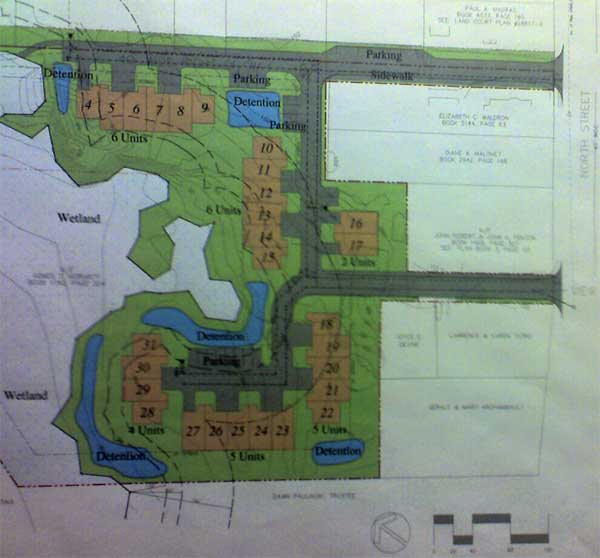Monday’s Gazette reports on erosion near a new subdivision in Southampton. There may be lessons with respect to the use of detention basins to manage stormwater. From “Southampton riverbank erosion under scrutiny”:
See also:
Kohl Construction condo proposal showing detention pools. At the base of the wetland lies Millyard Brook:

EPA: Do Stormwater Retention Ponds Contribute to Mosquito Problems?
Many ponds are not properly maintained, particularly in cases where they are installed in subdivisions and other developments where the entity responsible for long-term maintenance is not clearly defined once the construction is complete…
Wetland Values
Wetlands were long thought to be a nuisance because they were not suitable for development or most kinds of agriculture. We now realize that wetlands are not just valuable, they are invaluable. The following is a list of ways in which wetlands benefit people and the environment…
Flood damage control: Wetlands adjacent to rivers (riparian wetlands) can easily survive inundation by floodwaters and often actually benefit from regular flooding. Water that is allowed to flow over wetlands is slowed and partially absorbed, thereby reducing flood damage downstream. Wetlands are said to act as sponges because wetland soils can readily absorb water, and depressions associated with wetlands can fill up. This has the effect of trapping and slowly releasing water that would otherwise rush into the channel and contribute to flooding downstream…
Conservation officials here are still trying to determine whether a spring ‘blowout’ that dislodged thousands of pounds of sand from a wooded slope off Fomer Road was caused by nature or man…
The silt and sand took large trees with it down the steep slope and into Red Brook, which runs at the base of the hill in the town’s northwestern section…
A 39-home subdivision called Red Brook Estates, approved in 2003, remains under construction on the other side of the slope after several years of appeals from neighbors to state environmental officials…
Floyd said a stormwater detention basin 300 feet from the top of the approximately 60-foot slope may be the cause of the blowout, which was reported by an abutter in May after heavy rainfall…
See also:
Kohl Construction condo proposal showing detention pools. At the base of the wetland lies Millyard Brook:

EPA: Do Stormwater Retention Ponds Contribute to Mosquito Problems?
Many ponds are not properly maintained, particularly in cases where they are installed in subdivisions and other developments where the entity responsible for long-term maintenance is not clearly defined once the construction is complete…
Wetland Values
Wetlands were long thought to be a nuisance because they were not suitable for development or most kinds of agriculture. We now realize that wetlands are not just valuable, they are invaluable. The following is a list of ways in which wetlands benefit people and the environment…
Flood damage control: Wetlands adjacent to rivers (riparian wetlands) can easily survive inundation by floodwaters and often actually benefit from regular flooding. Water that is allowed to flow over wetlands is slowed and partially absorbed, thereby reducing flood damage downstream. Wetlands are said to act as sponges because wetland soils can readily absorb water, and depressions associated with wetlands can fill up. This has the effect of trapping and slowly releasing water that would otherwise rush into the channel and contribute to flooding downstream…